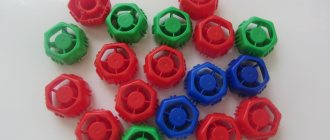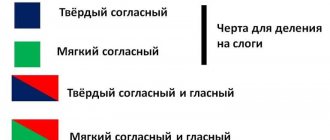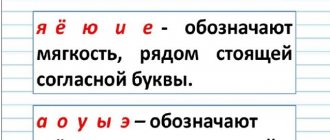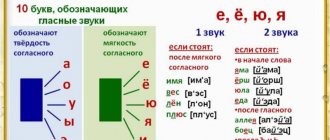a, o, u, i, y, e + 4 unusual letters e, e, yu, i
Why unusual? And why e, e, yu, I ONLY letters.... More on this later. So, ….
VOWEL SOUNDS
Stressed and unstressed vowel sounds
Vowel sounds are not always pronounced the same way. Observe the words: “STORK” and “ALBATROSS”.
Ask in surprise: “Is this a Stork?” Yes, it's Stork!
Is this an albatross? Yes, it's an albatross!
What is the first sound in the first word? What is the first sound in the second word? ... That's right, sound [a]. But is it pronounced the same?... No, in the word “stork”, the sound [a] is pronounced with force, with emphasis.
A syllable that is pronounced with stress is called a stressed syllable , a vowel with stress is a stressed vowel , and the amplification of the voice itself is called stress .
Vowel sounds without stress are called.... unstressed .
The emphasis is very important. What is shown in the pictures?
There is a castle and a castle here. Sometimes the meaning of a word, its meaning, depends only on stress .
To determine the stress, you can ask with surprise about this word, for example, “Is this a CASTLE?”, “Is this a FOX?” OR call out the word as if it was lost: “Zaaamok, zaaamok, ah!” “Lisaaaaaaaaaaaaaaaaaaaaaaaaaaaaaaaaaaaaaaaah, where are you?”
Read more about the Internet lesson on the Russian language “Accent”
Task 1. Name the stressed vowel. To find a stressed syllable, vowel, "ask in surprise" or "call" word:
school, drawing, mom, map, street, girl, flower.
Task 2. Tell us everything you know about the word, conduct a sound analysis of the word...
Plan for phonetic analysis of the word:
- Say the word. If necessary, clarify the meaning of the word.
- Say the word as they shout in the stadium, and find out the number of syllables, mark them with arcs.
- “Call” is the word. Recognize and mark the stressed syllable.
- Say the word, highlighting the first sound; give a description (is it a vowel or a consonant?) and label it. Then the second, third, etc.
- “Read” according to the diagram and check if the word comes out.”
About unusual letters... Online lesson in the Russian language “Letters E, E, Y, Y”
CONSONANT SOUNDS
Hard and soft consonants
Meet... these are the gnomes Tom and Tim...
What 1 sound do you hear in the name Tom [t]? This consonant sound is hard . Tom is just as tough and always chooses something that starts with hard consonants: he loves Tomato juice, wears a Coat, loves to blow Soap Bubbles.
What 1 sound do you hear in the name Tim? [t`] And this is a soft consonant sound . And Tima herself is as soft as the first sound in her name, and loves everything that begins with a soft consonant sound. For example, he eats Tima-Meatballs, eats Honey with pleasure, and paints only with a Brush.
Compare the words in the pictures...
Name the first sound in the words: bow and bandage. What did you notice?….
Consonants in Russian are hard and soft!
The sound [b] in the word “bow” is a hard sound , and in the word “bandage” [b`] is a soft consonant sound.
We will denote a hard consonant sound as follows:
And the soft consonant sound is as if we were adding another mattress to make it soft.
The hardness of consonant sounds is indicated in writing by the vowels A , O , U , Y , E or b.
The softness of a consonant sound is indicated in writing by the vowels E , E , I , Yu , I , as well as the letter b (soft sign).
Observe the first sounds in words:
- HOUSE - DIVAN [ house ] [ d`ivan ]
- L OM - L ES [ l om] - [ l `es]
- MASK - MINT [ mask ] [ m`ata ]
Shall we practice?
Task 1. Identify the first sound in words and characterize this sound (hard or soft):
Cow, linden, birch, crow, dog, rowan, bird cherry, cedar, mosquito, larch.
Task 2. Read the words, underline the letters of the hard consonant sounds with a blue pencil.
chair, ballet, performance, polka, bathhouse
Task 3. Read the words, underline the letters of soft consonant sounds with a green pencil.
kitten, kitten, hurt, coal, may
REMEMBER!
Always soft sounds: [th'], [h'], [h']. Remember the phrase: “ The black puppy ate the cucumber ” (this phrase always contains soft sounds).
Always hard sounds: [zh], [sh], [ts].
Task 4.
Answers: A1. 2) stump. A2. 2) car A3. 1) and 4) A4. 4) oak
Voiced and voiceless consonants
The sounds that surround us are quiet and loud. For example, the sound of an airplane engine and the rustling of leaves. These sounds are different in sound intensity, don’t you agree?
It turns out that speech sounds, consonant sounds can also be voiced and unvoiced...
Listen to the poems and find words that differ in one sound:
day outside . Everyone was hiding from the sun in the shade.
ear rustled in the wind , as if the field was singing out loud .
We whitewashed and sawed .
... One sound can change the meaning of a word! That is why we must try to speak clearly and clearly.
How to determine? Place your hand to your throat and make a sound. If the vocal cords vibrate, it is a ringing sound. If not, then you are deaf. Check - pronounce the sounds [b], [p], [m], [x]. Did you manage to notice?
Voicedness or deafness can be defined differently. Cover your ears with your palms and say a consonant sound. Did you hear a voice or noise? If a voice is heard, then the sound is ringing, if the noise is dull.
Task "Transformation of sound" . Turn a voiced sound into a dull one:
Daughter - (dot), heat - (ball), barrel - (kidney), slide - (crust), goat - (braid), firewood - (grass), guests - (bones), year - (cat).
So,
Unpaired voiced sounds [й❜], [l]-[l❜], [m]-[m❜] [n]-[n❜] [р]-[р❜] are called sonorant , which in translation from Latin means "resonant".
The sounds [zh], [sh], [ch❜], [sch❜] are called hissing . They got this name because their pronunciation is similar to hissing.
By the way,
- The sounds [zh], [sh] are unpaired hard hissing sounds
- The sounds [ch❜] and [ш❜] are unpaired soft hissing sounds.
The sounds [c], [s❜], [z], [z❜], [ts] are called whistling .
Important! A consonant sound is neither stressed nor unstressed.
In the Russian language, there are more consonant sounds (36) than consonant letters (21), since one letter can denote paired hard and soft sounds: for example, the letter L (el) denotes the sounds [l] and [l❜].
Online lesson in the Russian language “Voiced and voiceless consonants”
Learning tongue twisters...
The mouse in the corner has gnawed a hole and is dragging a crust of bread into the hole. But the crust does not fit into the hole; the hole is too big for the crust.
Pay attention to the Internet lesson on the Russian language “Sounds and Letters” for grade 2 to consolidate knowledge
How to explain to a child the difference between vowels and consonants?
Primary school teachers notice that phonetic analysis is one of the most difficult tasks for children. Indeed, in order to determine what sound is in front of you, the child needs to properly analyze it and remember how vowels and consonants are pronounced. Without a clear understanding of the difference, the child will be constantly confused.
To help your baby learn to distinguish sounds, follow these rules.
Do not tell your child that vowels are sung but consonants are not. Inventive children will show you how to sing the sound Z or M, and then confusion will not be avoided. The fact is that all sounds in our language can be divided into 3 groups: vowels are voice, voiced consonants are voice and noise, voiceless consonants are only noise. The sonorants closest to vowels are: r, l, n, m, j. Therefore, do not use the argument that vowels are sung, but sonorants are not, for the sake of your own further peace of mind.
The child will better remember the differences between sounds if he finds these differences himself. The main conclusion he must come to is that when pronouncing consonants, something constantly prevents the air from easily jumping out of the mouth: either teeth, then lips, and the sound M generally comes out through the nose. Give your baby a mirror and let him compare how his mouth behaves when he pronounces vowels and consonants in turn.
Tell a fairy tale: “A mouth is a house that has doors, a floor, and a ceiling. The vowel sounds lived happily and cheerfully in this house - they could easily run out into the street for a walk and no one would bother them.” Pronounce all the vowels - show that the mouth is really open, the tongue lies calmly, and the air comes out unhindered. “But one day an evil snake settled in this house and did not let its sounds out into the street. Either he will press them from the side, or he will close his teeth.” Say the consonants. “But the consonant sounds were smart and they came up with a way to outwit the snake. They began to hold hands with vowel sounds and run past the snake together. Try". The child should notice that when pronouncing open syllables, air comes out freely. “So, from then on, the sounds began to live together and they were not afraid of the snake.”
First, teach your child the vowel sounds, and then the consonants. Please note that individual consonant sounds are read briefly, but together with vowels they can be drawn out for quite a long time.
Practice distinguishing sounds in the game. Prepare cards with pictures and words: ball, house, cheese, whale, meadow, forest. These words have all the vowel sounds. Place the first card in front of the child and ask a riddle: “This word has an unusual sound that you can shout the loudest, sing the longest, when you pronounce it, neither your teeth, nor your lips, nor your tongue interferes with you.” Give your child the opportunity to scream a sound and look at himself in the mirror. Rest assured, the baby will find the solution!
Festival of vowel sounds in preschool educational institutions. Preparatory group
Festival of vowel sounds in kindergarten
Description: This material can be used by teachers of senior and preparatory groups in classes on the development of sound culture of speech and in preparation for learning to read and write. This development may be useful for teachers of 1st grade of primary school. Goal: Improve the ability to distinguish all vowel sounds by ear and pronunciation. Objectives: Improve phonemic awareness: learn to name words with a certain vowel sound, determine the place of the vowel sound in a word. Learn to pronounce words with vowel sounds clearly and clearly. Learn to identify the sequence of sounds in simple words. Learn to form syllables. Learn to form words from syllables. Develop attention and memory. Develop the ability to listen to your interlocutor and not interrupt unnecessarily. Equipment: Videos “Sounds of Nature”, “Song of Vowel Sounds”.
Subject pictures: stork, kangaroo, house, oak, cat, crayfish, beetle, whale, catfish, onion, cheese. Cards with vowel letters for children and the teacher (the teacher has a larger size). The teacher has a typesetting canvas and a cut alphabet. Magnetic board. Cards in red, blue and green for creating word charts for the teacher and children. Individual mirrors. Progress of the holiday - activities
Educator: Let's watch the video. Educator: What did we hear? Children: We heard the sound of rain, wind, sea. We heard birds singing, sounds of the night forest. Educator: Where can you hear these sounds? Educator: Let's watch another video. Educator: What did you hear? Children: This is a song of the sounds a, o, u, and, e. What sounds are these? What sounds are called vowels? Yes, these are sounds that are pronounced by voice, voice. And they live in the same magical country. The residents' houses there are blue, green and red. ( The teacher shows the cards.
) What color are the houses of the vowel sounds?
Children: They live in red houses. Educator: Let's sing a song of vowel sounds. The children are singing. The teacher pays attention to articulation when pronouncing vowel sounds. Educator: How are they sung? Children: The air in the mouth does not meet any obstacles, the sound is sung by voice. Educator: These sounds are always sung, These sounds flow like songs. These sounds fly freely on their way without meeting any obstacles. Educator: In which houses do consonant sounds live? Children: In blue and green houses. Blue houses contain hard consonants, and green houses contain soft consonants. Educator: But consonant sounds cannot sing without vowel sounds. Therefore, they live with them in friendship and harmony. Educator: And when consonants are combined with vowels, what do they form? Children: Syllables. Educator: And what is formed from syllables? Children : Words. Educator: And from words? Children: Suggestions. Educator: And you can see the inhabitants of this magical country. Children: Yes. Each sound has its own letter. Educator: Today in this magical country is a holiday for vowels.
And that’s why they will be the main characters today. These are the vowels! A, O, U, E, I. Name them. Where is the letter Y? She was probably offended and hid, because the sound she represents was not a vowel sound in the song. We will definitely find her. And where to look for it? Who knows? Of course in words. To remember the letters well, lay them out from counting sticks. Game “Make vowels from sticks”
Children write out letters in pairs.
Game “Where is the vowel sound?”
Educator: Guess the riddles: The children say the riddles.
This is an old friend of ours.
He lives on the roof of the house. He flies to hunt for frogs in the swamp. (Stork)
Educator: What sound do we hear at the beginning of a word? What sound is this? What letter is at the beginning of the word? Show. This is necessary! Miracle right! The mother is calm for the children, Because she carries the children in a bag... (kangaroo) .
Educator: What sound do we hear at the end of a word? What sound is this? What letter is at the end of the word? Show. These cubes stand on top of each other exactly in a row, Each one has a window and an entrance, Someone lives in each one. (House)
Educator: What sound do we hear at the end of a word? What sound is this? What letter is at the end of the word? Show. He is in the forest, like a hero - all huge - up and down! The leaf is beautiful, cut, green in summer and spring. The autumn giant is glad to put on his brown outfit. From the branches, as if for fun, he scatters acorns. (Oak) O. Kisileva
Educator: What sound do we hear in the middle of a word? What sound is this? What letter is in the middle of the word? Show. Where can vowel sounds be found in a word? What did we call in words? What did they show? Educator: And now I invite everyone to a fun warm-up.
"Fun exercise"
Game "Name the sound?"
Educator: I will name the word, and you will determine what vowel sound is in the word and raise the corresponding letter. Smoke (S), ball (A), dream (O), noise (U), sir (E), bull (S). Educator: So we found the sound Y. Or maybe the letter Y is tired of hiding? Found it? Show. Let's put it next to our friends with different vowels. Vocabulary work: mayor. Educator: I will show the picture, and you will pronounce the vowel sound, highlighting it from the name of the picture, and raise the corresponding letter. Cat (O), crayfish (A), beetle (U), whale (I), catfish (O), onion (U), cheese (Y). Educator: What did you find in the words? Children: Sound. Educator: What did they show? Children: Letter.
Game “Vowels Got Lost”
Educator: To make words, you need to find the right vowel letter.
Educator: What did you put in the words? What did they offer? Vocabulary work: sir.
Outdoor game
(Children stand in a circle.)
We are de-li-li a-pel-sin, There are many of us, and he is o-din: E-ta dol-ka - for e-zha, E-ta dol-ka - for the haircut, This share is for the little ones, This share is for the kittens, This share is for the beaver, And for the wolf - the cat zhu-ra. He's angry with us - bad luck! Get out of your way!
Game “Say the syllable”
Educator: I will say the first syllable, and you will say the second. (Lozh - ka, spich - ka, kni - ga, doo - hee). How many vowel sounds are there in these words? How many syllables? Conclusion: There are as many syllables in a word as there are vowels. Educator: I will name the first two syllables, and you will name the third.
(So - ba - ka, ko - ro - va, py - le - sos, sa - mo - fly). How many vowel sounds are there in these words? How many syllables? Conclusion: There are as many syllables in a word as there are vowels. Game "Visiting the Vowels".
The teacher picks up the consonant letter M. Educator: The letter M came to visit the vowels and greeted all the vowel letters in turn.
First she said hello to the letter A and they said MA. Then I greeted the letter O and they said MO. When M took Y's hands they said MU, then she greeted I and they said MI, when meeting E they said ME, when M took Y's hand they said WE. The letter P came to visit (the children continue the story). Game “Match words to diagrams”
Educator: How many sounds should there be in a word? Children: Three.
Nose, juice, ray, noise, soup, fluff, son, rear, world, feast, rice. Result
Teacher: What sounds are called vowels? Children: Vowels are sung and do not encounter obstacles during pronunciation. Educator: Name them. Children: A, O, U, I, E, Y. Educator: How can you use vowels to determine the number of syllables in a word? Children: There are as many syllables as there are vowels in a word. Educator: Do you think the vowel sounds are satisfied with your knowledge? Let's sing the vowel song again.
We recommend watching:
A holiday about tea in the preparatory group. Scenario Speech therapy holiday in elementary school. Scenario: Drawing festival for the preparatory group in kindergarten. Scenario Holiday for children of the preparatory group together with their parents. Our Motherland is Russia
Similar articles:
Physical education leisure in the preparatory group in the winter in the hall
Physical education holiday in the preparatory group with parents
Celebration in the pool in kindergarten. Scenario for the preparatory group
Scenario for an animal holiday in kindergarten. Preparatory group






